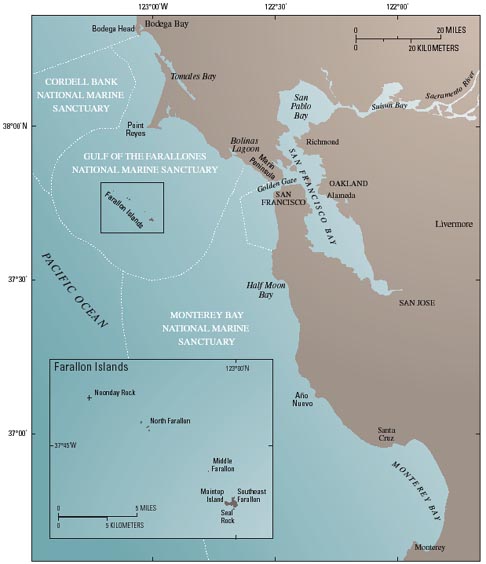
A hill climb from Santa Cruz to the Farallons
Copyright (c) 2003, John Harker

On a late summer weekend two friends and I sailed "Prana" from Santa Cruz to the Farallon Islands (off of San Francisco) and back. Our first time going any significant distance up the Northern California coast, and first time sailing overnight on the open ocean. Prana is a 1986 Catalina 27 that my father and I bought used in Sausalito and, after a summer on the San Francisco Bay, sailed down to Santa Cruz five years ago. When we got her we replaced all the rigging and lifelines, added an electric bilge pump and autopilot, and fixed various electrical and plumbing problems. Since then we have done lot of other work such as adding interior handrails, some cleat backing plates, a new cutlass bearing, a folding prop, and new jib, main and gennaker. We are fortunate in having a lower harbor slip, which means we don't have to drop the mast to go sailing. It’s harder in Santa Cruz to get a lower harbor slip than a boat!
Along with me on the trip was John Andrich and Don Draper, who are part of Prana's regular Wednesday night race crew. The Wednesday night races around here are well attended, usually 20-40 boats. It is a windward/leward 'rabbit' start race where the starting line is made by the starting boats stern crossing the single starting mark and the expanding interval between her stern and the mark. It's not a PHRF or any kind of a handicap race but the average PHRF of the boats racing is probably around 100, so though I think we sail the boat well, we generally are in the rear. We successfully race with the back of the pack against the Cals, Catalinas and Benateaus in the 27-35 foot range. It is a lot of fun.
However I digress...
Due to work schedules we wanted to do this in a weekend. Kissing our wives goodbye we started out Friday night around 5:30. The plan was to leave Friday around 5:30 PM, sail through Friday night and Saturday morning to the Farallon Islands (70nm). Then round them, sail Saturday afternoon to Half-Moon Bay's Pillar Pt Harbor (30nm) for a dinner ashore and night in harbor. Then sail Sunday morning and afternoon back to Santa Cruz (45nm) and arrive around 3:00. I posted a voyage plan with the Harbormaster. The boat is up to snuff with regard to Coast Guard requirements and has the needed charts. We topped off the fuel tank and filled the water tank before we left. In addition to the Coast Gurard requirements we had a Lifesling, a Horseshoe buoy w/marker, a spotlight, three VHFs (the boat's and two portable), three GPSs, and several cell phones. We usually wore harnesses in the cockpit and always when going forward. On the other hand, we had no EPIRB and our only life raft was a deflated 8' dinghy. But we were off.
The Farallons are named from the Spanish word "Farallones" for islands - are about 25 nm miles off the coast of San Francisco in Northern California and about 70 nm upwind from Santa Cruz. In the summer the ocean here generally has 15-25 knots steady, dropping in the night and picking up at around 12:00. The waves are a ragged mix of wind waves and ocean swell, usually 6 to 8 feet, short and steep, and at the early breaking stage. This makes it very difficult to make progress upwind, which is what sailing up the coast means here. Hence the ‘hill climb’. At night the wind lightens and the seas usually calm down. I was counting on the smoother seas at night to motorsail up the coast. If we didn't make the Farallons by noon the next day it would become much more difficult to do so after the afternoon winds came up.
What really happened is it blew 20 knots and the wind and waves didn't drop till after midnight and even then only a little. Go figure. Starting out of Santa Cruz until around 11:00 P.M., we were brutally bashing almost directly upwind. Hard work. We pitched so much going over the waves that as we crested the bow would drop 3-4 feet and pound into the back of the wave below. A number of times the prop came out of the water - and this is an inboard diesel engine. We don't have a dodger and even the winch handle compartments were full of water from the spray. Frequently we would be looking at the bow lights on the pulpet under water as we pitched off a wave into the base of the next. It got better (less rough) as the night progressed, but standing watch at the helm was like standing in front of a large cold salt-water hose till almost daylight. One interesting unanticipated problem was that each time we pitched down the wave the sliding hatch cover would forcefully slide open, exposing the cabin to the elements. We wound up tying it off with a line from it's handle to the cleat next to the starboard Jib winch.
During this first part of the voyage it took us forever to get past Davenport, a town about 10 miles north of Santa Cruz. We were only making between 2 to 3 knots despite running the engine close to flat out, and our schedule called for 4. It was looking like we were not going to make it to the Farallons, but we decided to stay on course rather than divert directly to Half-Moon Bay.
I also got seasick, which usually doesn't happen, and it took until about 12:00 A.M. until the patch I belated applied started to work. This made the navigation chartwork below a nightmare. The best I could do was roughly hourly chart plots, which turned out OK but wasn't what I have been taught as best practice.
John Andrich took the first watch that turned into a marathon 6 hour stretch. Don went to sleep early in the quarterberth. I did brief bits of navigating mixed between catnaps and being sick. After 11:00 P.M. or so our speed started to pick up as the waves went down a little. Now it was between 3 and 4 knots.
I took the helm at midnight. John Andrich took over the quarterberth and Don moved to the foreberth(!). Both slept, although later Don complained that he kept waking up a foot in the air just as he crashed back down on the bunk. I was surprised he could sleep there at all. During this time we passed the Pigeon point lighthouse, some 30 miles north of Santa Cruz. It remained visible for the rest of my watch off the stern as we headed offshore. We were in the shipping lanes for boats entering and leaving San Francisco and so we kept a close watch out. They move at 25+ knots and really can go from the horizon to hitting you in 15 minutes. Several ships passed by in the distance, but as the weather was overcast with no fog their lights made them easy to see. The wind and waves moderated further and our speed increased to 4.5 to 5 knots.
Don took over at 3:00 A.M. We were now out of sight of land, but not ships. We had been steering a compass course (305 degrees) since about 11:00 P.M., and both Don and I noticed that if something distracted you (like restraining our wildly swinging radar reflector or dodging a passing ship) the lack of external references made it easy to become disoriented until you sorted things out and got back on course. At about 6:30 A.M. he handed the watch off to John Andrich. We were now making better than 5 knots and about 8:30 in the morning we saw the islands on the horizon.
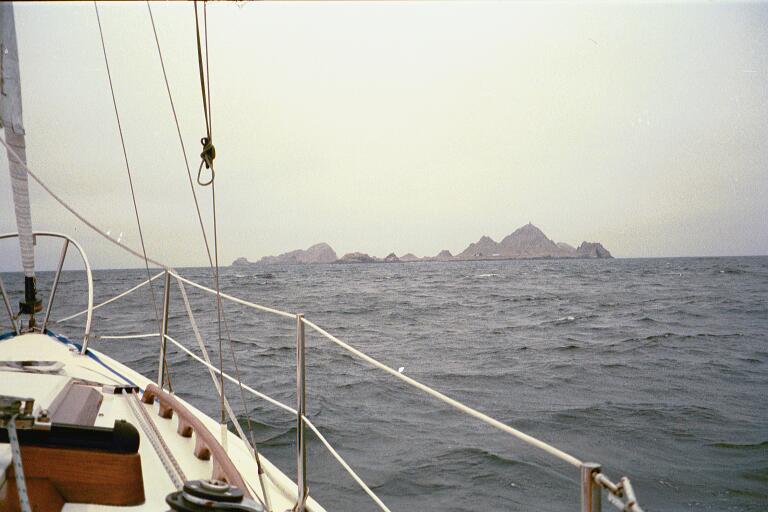
The Farallons are just craggy rocks. No fresh water. Lots of birds and sea
lions. Eerily beautiful with maybe 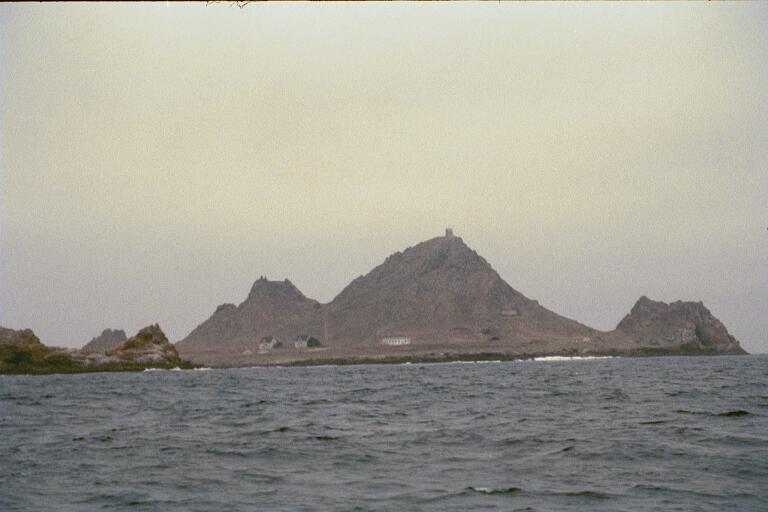 four
trees. Almost like the Island in Myst, if you have ever played that game. They
were a source of eggs for the early California goldminers, but other than that
they are only sparsely inhabited by lighthouse keepers and scientists. There
is no natural landing. They are often shrouded in fog, but we just had overcast
skies and got a good view. We were going to round the South-most island which
is the largest. As we came closer we saw numerous large sea caves and arches.
Some of the arches were around a hundred feet up and must have been made in
earlier times when the sea level was higher. There were a small number of scientific
research buildings of various styles (Victorian house to modern shipping container)
looking out of place amongst the rocks. We
four
trees. Almost like the Island in Myst, if you have ever played that game. They
were a source of eggs for the early California goldminers, but other than that
they are only sparsely inhabited by lighthouse keepers and scientists. There
is no natural landing. They are often shrouded in fog, but we just had overcast
skies and got a good view. We were going to round the South-most island which
is the largest. As we came closer we saw numerous large sea caves and arches.
Some of the arches were around a hundred feet up and must have been made in
earlier times when the sea level was higher. There were a small number of scientific
research buildings of various styles (Victorian house to modern shipping container)
looking out of place amongst the rocks. We 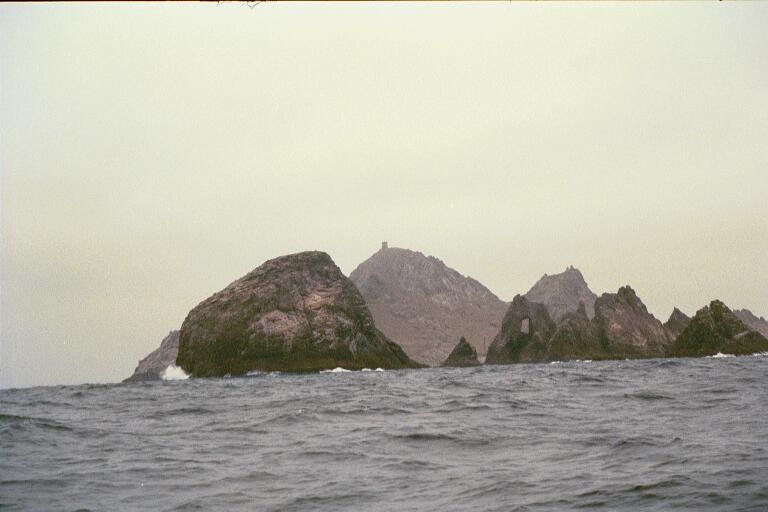 rounded
the Island around 11:00 A.M. and headed back to Half Moon Bay on a SE course.
rounded
the Island around 11:00 A.M. and headed back to Half Moon Bay on a SE course.
We spent the rest of the day making several large zigs downwind, varying between a broad reach and a wing-on-wing run. Not the shortest path but the best sailing course. We made coffee and soup on the pressurized (and so always exciting) alcohol stove and finally ate. We hadn't been able to eat the dinner we brought along the night before. With winds light we made 4-5 knots all day and got to Half Moon bay around 4:00 PM. We called in on the VHF and reserved a visiting slip. Half Moon bay is tricky to enter because there is a hidden shoal line blocking much of what seems like an open bay. You have to pay close attention to the channel buoys. Pillar Point harbor itself is great with two layers of breakwater and complete facilities. We refilled our now 3/4 empty fuel tank at the fuel dock, found our slip and after straightening out the boat took a welcome hot shower ashore. We had a great Italian dinner at a restaurant called Mezza Luna, played a little guitar and, exhausted, crashed for the night by 9:30 P.M.
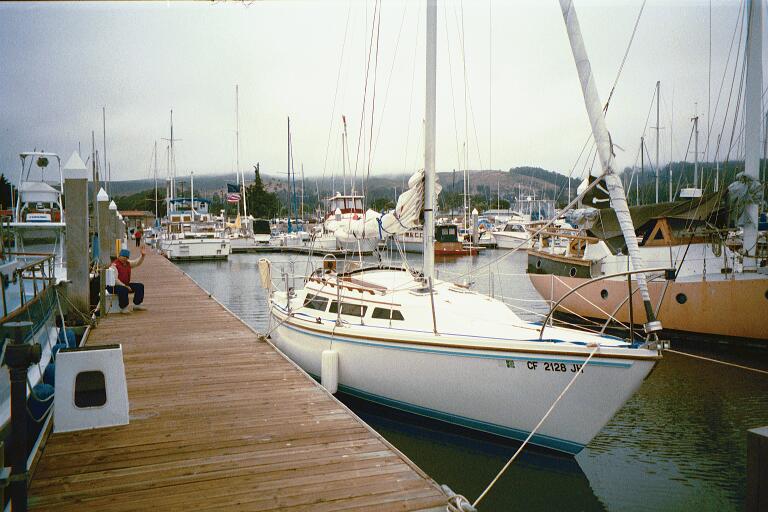
Next morning we got up and made coffee and were off by 7:00 A.M. Heading South we motorsailed at about 5 knots. The day before the wheel had started to bind occasionally which concerned us. I had stood on my head to look at the cable and quadrant and found an old dock line nestled against it, but nothing else was visibly wrong and the problem persisted. So we were worried about the steering. Taking it as an opportunity to check out the emergency setup we fitted the emergency tiller and tried it out. Very hard to steer, there was a lot of friction in the system and when put amidships the pedestal was very much in the way. Due to the friction in the system we decided we would have to detach the steering cable in order to use it (another potential use for the bolt cutters we carry). We also tried steering with the dinghy paddle fitted with 6-foot long aluminum pole extension that I had made. This we lashed to the stern and used as a steering oar. This worked but we decided that in order to really use it we would have to tape and lash it to the whisker pole to lengthen and stiffen it. Happily the wheel steering continued to function well, though we stayed a little further offshore than the course dictated just in case.
About 11:00 the wind came up (20+knots), the sun came out, and we turned off the engine and started surfing the waves with a wing-on-wingsetup. A wild ride and really great sailing! Flying downwind at 6-8+ knots we passed Pescadaro and Pigeon Point. We had lunch as we passed Ano Nuevo. A lone windsurfer came out to check us out as we passed Waddel creek, a famous local surfing and windsurfing spot also known for shark attacks. We reached Davenport at around 1:30. Rounding Lighthouse point as we entered Santa Cruz and approached the shore the wind died and we spent a half-hour tacking back and forth at the shifting boundary between the onshore ocean wind and the afternoon offshore land breeze. Eventually we started the engine and motored into the harbor. We docked in Santa Cruz at around 3:00 in the afternoon. What a trip! We were out for 40 hours, sailing approximately 140 nm in 27 hours with one rest in Half Moon Bay.
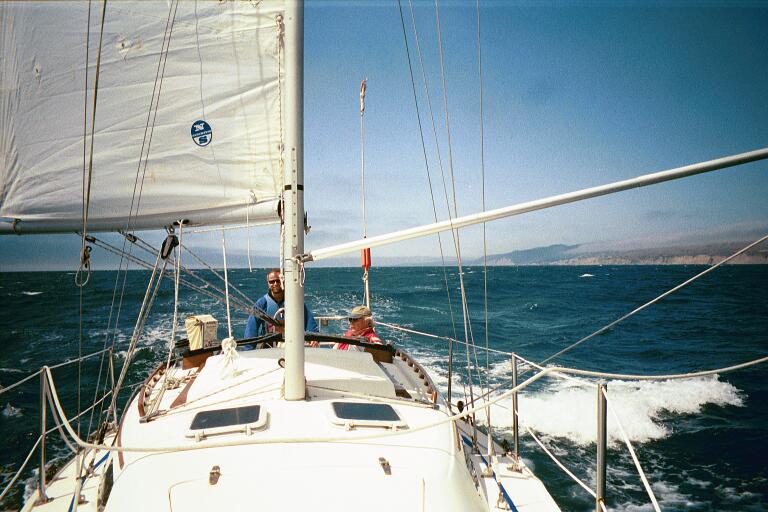
In retrospect, we had numerous small problems such as the steering problem (lubing the cable fixed this) and having the fuel tank exhaust vent clog (gunked up exhaust screens made fueling a slow process). None the less, the boat came through with flying colors. It stayed mostly dry in the cabin with few drips, even while the bow was underwater. The engine ran faithfully at high rpms all night through the worst of the weather. The lights and power stayed on, the mast stayed up, the sails stayed whole, and the steering kept working. We kept warm and, though we ate less than half the food we brought, ate well. The navigating was successful, we hit the islands and Half Moon bay spot on. The downhill run was bliss.
We are already talking about next time, maybe sail up to Bodega bay or down to Carmel Bay for the night, then down the Big Sur coast for a day followed by a motorsail passage back up that night.